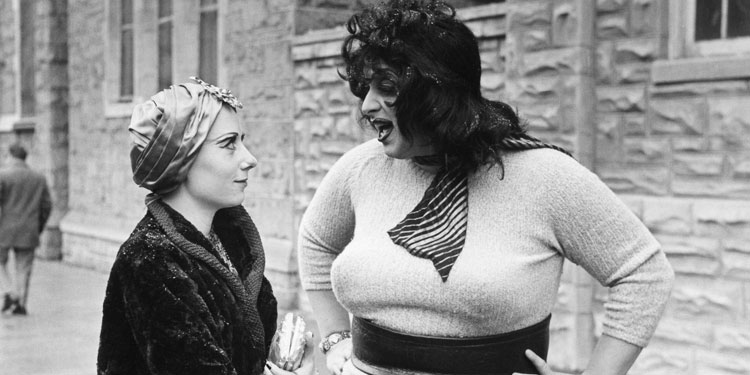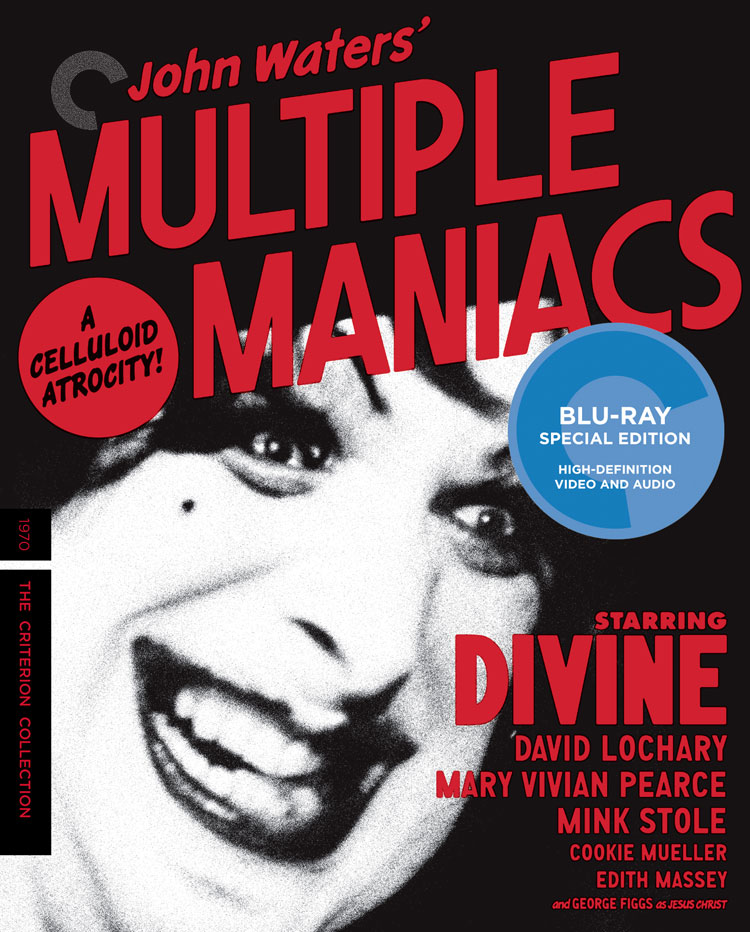
Director: John Waters
Running Time: 94 mins
Certificate: 18
Release Date: March 20th 2017 (UK)

Even 47 years on, it’s sometimes difficult to know what to write about John Water’s early work. While he later tempered some of his more depraved urges and found a wider audience with the likes of Hairspray, Serial Mom and Pecker – although all still with the unique Waters stamp – when he first started out he was blazing a trail unlike anyone else.
Multiple Maniacs was Waters’ first feature-length sound movie, made in Baltimore at the tail end of 1969 with a cast and crew composed largely of his friends. It opens with Mr. David (David Lochary) trying to entice people into a tent to see Lady Divine’s Cavalcade Of Perversions. The straight-laced punters aren’t impressed by the ‘real-life queers’, drug addicts, armpit lickers and naked pyramids they find in the tent, and are even less pleased when they discover it’s all been a ruse to kidnap, rob and possibly kill them.
The Show is ruled over by the fierce Lady Divine (Divine), a woman who takes no prisoners, loves to kill and has few boundaries. She’s been dating Mr. David, but her boyfriend has been seeing another woman, so she decides the only solution is to kill both of them. However, on her way to commit ‘extreme unction’ she has an unexpected religious experience and a lesbian encounter in a church – where penetration with a rosary is juxtaposed with the Stations of the Cross. Meanwhile, Mr. David and his new lady know that Lady Divine is going to be angry, so they decide to kill her first.
That all leads to a finale that is vaguely Shakespearean, a bit like Godzilla and features more rape-by-lobster than pretty much any other movie ever made.
As you might be able to guess form that synopsis, I wasn’t kidding when I said early John Waters was unlike anyone else. Some have labelled the likes of Multiple Maniacs and Pink Flamingos as a kind of perverted camp – but that rather simplifies things. While the movie is completely insane, juvenile and you can see the director and his cast pushing at being as shocking as possible, there’s also an oddly arty edge. It’s clear Waters knows his cinema, from Bergman to Cassavetes, and from the work of Andy Warhol/Paul Morrissey to the surrealist cinema of the likes of Luis Bunuel. It ensures that no matter how demented or silly it gets, it never feels purely gratuitous or disjointed, as there’s clearly a bizarre but smart brain at work holding it together.
Even something that seems shocking for the sake of being shocking – such as Divine being screwed with a rosary by another woman, interspersed with a recreation of the crucifixion of Jesus – isn’t completely gratuitous. It is admittedly a massive middle finger to organised religion, but it’s also poking fun at serious art cinema’s pretentious tendencies. Here Divine is having an arthouse Road To Damascus experience, but rather than it showing her that she must turn her life around and devote herself to the poor, she decides it means she was right to have spent her life being depraved and that God approves of her plan to kill Mr. David.
It is a very peculiar film, but it’s also a very entertaining one (although Christians with no sense of humour should steer well clear), which defies classification. It’s also looking better here than it ever has before. As Waters reveals in the commentary, when he was asked what sort of restoration he wanted when the movie got cleaned up in 2016, he decided he wanted the full works. Although the fact it now looks crisp and clean may result in some thinking that removes a little of the charm of a black and white movie made on a shoestring in 1969, overall it works extremely well. Not everything has been removed, as they’ve ensured some of the rougher hewn elements remain, such as slightly off-tempo edits that are more about how 16mm film worked and the fact Waters’ didn’t have the money to film numerous shots of each scene and be able to edit them together.
It’s also true that some of the acting is rough around the edges – but it should be noted that despite being made by a bunch of ‘amateurs’ from Baltimore, the acting is no worse than a lot of other art cinema of the time. It also features many of the people who would go on to be Waters regulars, such as Divine, David Lochary and Mink Stole. In her first starring role, Multiple Maniacs provides early evidence of what a contradictory force Divine was on-screen, as in pretty much every role he took he managed to be both terrible and brilliant simultaneously, which is fairly impressive feat.
Although this Criterion edition doesn’t have quite as many Special Features as some of their other releases, it’s well worth delving into what it does have. As mentioned, there’s a commentary from John Waters, who’s his usual genial and interesting self, giving fascinating anecdotes about the making of the movie – not least how they got a priest to agree to let them film the lesbian rosary scene in a real church – as well as the difficulties of getting it to audiences because of its subversive and ‘shocking’ content. Also included is a featurette intercutting new interviews with various people who appeared in the film, including the likes of Mink Stole, as well as a sort of visual essay by Gary Needham, who talks about the movie and its influences.
Even now, Multiple Maniacs is a movie that will have the power to shock some. And of course it should be remembered that this was made at a time of great division in American society, with anti-Vietnam rallies, flower power and hippies, However, Multiple Maniacs Waters created a true outsider movie, glimpsing a world beyond any of those things, making a film about those that didn’t fit any paradigm.
Thankfully, there are plenty out there who will enjoy entering the perverted world of early John Waters. Multiple Maniacs may not be as famous as the likes of Pink Flamingos and Polyester, but as pure cinema, it may actually be a better film.
Overall Verdict: Multiple Maniacs is still not a movie for the easily shocked, but this bizarre, queer, middle finger to nearly everything is oddly mesmerising, and looks great on this new release.
Reviewer: Tim Isaac
Leave a Reply (if comment does not appear immediately, it may have been held for moderation)